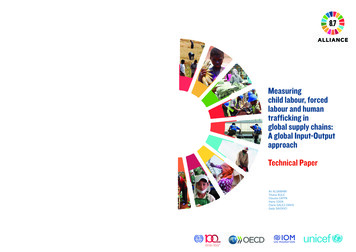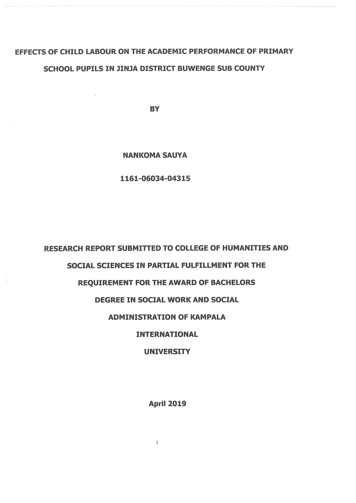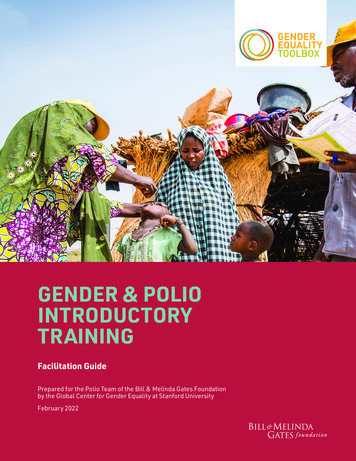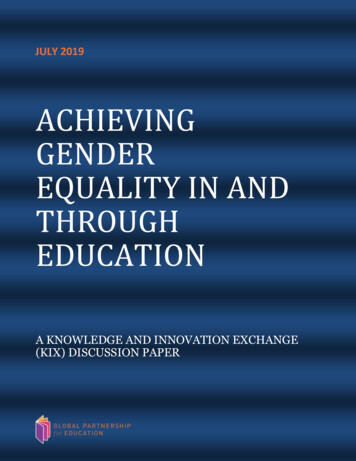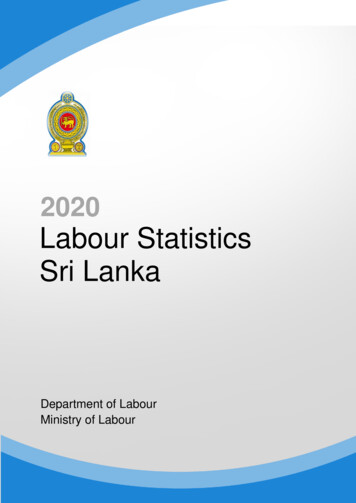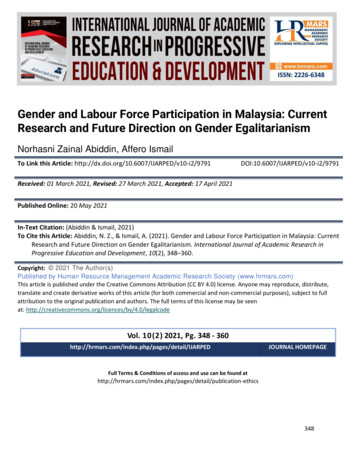
Transcription
International Journal of Academic Research in Progressive Education andDevelopmentVol. 1 0 , No. 2, 2021, E-ISSN: 2 2 2 6 -6348 2021 HRMARSGender and Labour Force Participation in Malaysia: CurrentResearch and Future Direction on Gender EgalitarianismNorhasni Zainal Abiddin, Affero IsmailTo Link this Article: 0.6007/IJARPED/v10-i2/9791Received: 01 March 2021, Revised: 27 March 2021, Accepted: 17 April 2021Published Online: 20 May 2021In-Text Citation: (Abiddin & Ismail, 2021)To Cite this Article: Abiddin, N. Z., & Ismail, A. (2021). Gender and Labour Force Participation in Malaysia: CurrentResearch and Future Direction on Gender Egalitarianism. International Journal of Academic Research inProgressive Education and Development, 10(2), 348–360.Copyright: 2021 The Author(s)Published by Human Resource Management Academic Research Society (www.hrmars.com)This article is published under the Creative Commons Attribution (CC BY 4.0) license. Anyone may reproduce, distribute,translate and create derivative works of this article (for both commercial and non-commercial purposes), subject to fullattribution to the original publication and authors. The full terms of this license may be seenat: deVol. 10(2) 2021, Pg. 348 - DJOURNAL HOMEPAGEFull Terms & Conditions of access and use can be found tion-ethics348
International Journal of Academic Research in Progressive Education andDevelopmentVol. 1 0 , No. 2, 2021, E-ISSN: 2 2 2 6 -6348 2021 HRMARSGender and Labour Force Participation in Malaysia:Current Research and Future Direction on GenderEgalitarianismNorhasni Zainal AbiddinUniversiti Pertahanan Nasional MalaysiaAffero IsmailUniversiti Tun Hussein Onn MalaysiaAbstractAlthough, income inequality and poverty are being subtly addressed; the often-neglected link isthat poor labour force participation among women has serious implications on endemic incomeinequality and poverty. Even though, women are acquiring knowledge, skills, abilities and otherlabour related characteristics like their men counterparts, they face considerable discriminationsin the employment market. The continued labour participation imbalances against women aresuggestive that, the current employment landscape is not yet inclusive and robust. In the currentemployment terrain, women are disproportionately disposed to making a compromise betweenpaid job and home caring responsibilities. Although, the current review is not an exhaustivedesigned to cover every issue connected with gender labour participation disparity, the study willachieve the following key objectives. First, to bring into perspective the, underlying structuralimbalance in female labour force participation. Second, to provide policy intervention which arenecessary to improve female labour force participation. The review found that, while significantimprovements have been made in terms of educational opportunities and economicliberalization which improved women participation, there are substantial structural, cultural andinstitutional impediments that are still holding women back. These obstacles require robustpublic policy advocacy, committed leadership in implementing relevant gender supportivebehaviours.Keywords: Gender, Labour Force Participation, Income Inequality, Egalitarianism, WorkplaceDiscriminationIntroductionEconomic growth and development have taking a new turn, occasioned by rising technologicalinnovations. While huge opportunities have been created in the midst of profound tech349
International Journal of Academic Research in Progressive Education andDevelopmentVol. 1 0 , No. 2, 2021, E-ISSN: 2 2 2 6 -6348 2021 HRMARSinnovation, revolution and advancements; enormous challenges have emerged, especially in thecontext of rising income inequality, huge poverty, poor labour force participation for women anderosion of social fabrics. Although, income inequality and poverty are being subtly addressed; theoften-neglected link is that poor labour force participation among women has seriousimplications on endemic income inequality and poverty (Djankov, Trumbic & Zhang, 2020; Kelly,Watt, Hardie & Lawson, 2021). The aging populations and dwindling labour productivity make aninclusive labour participation, a compelling economic and social issue to address (Kelly et al,2021).Even though, women are acquiring knowledge, skills, abilities and other labour relatedcharacteristics like their men counterparts, they face considerable discriminations in theemployment market. The continued labour participation imbalances against women aresuggestive that, the current employment landscape is not yet inclusive and robust (Djankov et al,2020). In the current employment terrain, women are disproportionately disposed to making acompromise between paid jobs and home caring responsibilities. Also, in few of the availableemployment opportunities, women are compelled to accept lower pay compared to their mencolleagues (Lagarde & Ostrov, 2018).The Covid-19 pandemic has worsened the gender pay disparity (Alon et al., 2020). This uglydevelopment is credited to two factors which are linked together. The first is that, most of thesectors which were affected were those sectors that employ more women. The second is thesudden increase in home/family and care giving duties based on school shut down (Landivar etal., 2020). While these challenges may be easily visible in developed countries such as US,Canada, Japan, South Korea, UK and Australia due to available employment data; manydeveloping countries with huge underlying economic, social and cultural problems are equallyfeeling the blunt of gender induced structural inequalities.Although, the current paper is not an exhaustive review designed to cover every issue connectedwith gender labour participation disparity in Malaysia, the study will achieve the following keyobjectives.1. To bring into perspective the, underlying structural imbalance in female labour forceparticipation.2. To provide policy intervention which are necessary to improve female labour forceparticipation.Theoretical Foundation and Literature ReviewStructural Imbalance in Labour Force ParticipationAlthough, women have increased their educational status and relevant skills in other to attainhigher employment standing like their men counterparts, the supposedly skill improvement hasnot translated to job improvement and career prospects for women. Despite significantimprovement in cultural, attitudinal and childcare policies in relation to gender gaps from thebeginning of the century, female labour participation has been low even in developed countries(Lagarde & Ostry, 2018). From the perspective of gender differences, female and male employeesbring different skills into the workplace (Greenhaus, Peng & Allen, 2012; Jolly et al., 2014;Lagarde, 2014). If the perspective of gender differences hold, female employees are more likely350
International Journal of Academic Research in Progressive Education andDevelopmentVol. 1 0 , No. 2, 2021, E-ISSN: 2 2 2 6 -6348 2021 HRMARSto be satisfied from their work and peers while male employees drive much satisfaction fromsupervisors and pay (Okpala, Squillace & Erondu, 2005).Also, from the viewpoint of work identity studies, female employees spend more time on familyrelated responsibilities (Greenhaus et al, 2012). However, other scholars hold the views thatmale and female employees have similar characteristics (satisfaction and behavioural) on workrelated issues and where possible, the differences are negligible (Hyde, 2014; Powell &Butterfield, 2013). The structural inequities in the employment landscape, even in developedeconomies negate the concept of egalitarianism, which is designed to promote fairness andjustice in the workplace (Thijs et al., 2019).While considerable gender improvements have been achieved, substantial discrimination andexclusion still exist (World Economic Forum, 2015).Theoretical BackgroundGender egalitarianism supports the notion of equality in terms of roles, rights andresponsibilities. Essentially, gender egalitarianism is a belief system that hold the view that maleand female should be treated equally in all economic, social and political landscape (Thijs et al,2019). The perception that female is suited for homemaking and homecare while the malecounterpart as the breadwinner falls short of the belief of gender egalitarianism (Davis &Greenstein, 2009). Even though, gender disparity has reduced in developed countries, existingstudies have not fully captured the within-differences among countries (OECD, 2017). While,macro-level economic policy and social contexts have been credited with little improvements inmany advanced countries in terms of gender gaps (Kesler, 2018; OECD; World Economic Forum,2015), substantial discriminations still exist in terms of social class, cultural disposition, educationattainment and religious practices (Olivetti & Petrongolo, 2017; Röder & Mühlau 2014).Educational attainment has reduced the gender gaps and, in many countries, girls have enrolledmore than boys in primary and secondary schools. In countries, such as Morocco, India, Turkeyand Indonesia, females are currently attending tertiary education more than males (OECD, 2016).Two major theoretical perspectives are principally adopted to explaining individual position ongender egalitarianism: (1) interest-based perspective and (2) socialization or exposureperspective (Thijs et al, 2019). While, interest-based theoretical perspective posits thatindividuals accept and preserve attitudes and behaviours which are consistent with theirindividual goals and interests (Bolzendahl & Myers, 2004), socialization or exposure perspectiveargues that individuals adopt and preserve attitudes and behaviours when they are exposed toliberal or gender supportive beliefs (Davis & Greenstein, 2009). Socialization or exposure,perspective is credited with increased in female egalitarian views because females are essentiallyin disadvantageous position unlike their male counterparts (World Economic Forum, 2015), thussupporting gender equality is benefial for them.Men, in many conversative dominated societies like Malaysia are essentially driven by interestbased viewpoints (Bolzendahl & Myers, 2004). In most of these societies, gender supportivebeliefs would undermine their privileged positions (Davis & Greenstein, 2009). Although, the twoindividual levels theoretical perspectives (interest and exposure) are necessary to understand theexisting gender disparity (Thijs et al, 2019), they may not be sufficient to explain the continuedchanges in social- cultural development in the context gender egalitarianism. The pace of351
International Journal of Academic Research in Progressive Education andDevelopmentVol. 1 0 , No. 2, 2021, E-ISSN: 2 2 2 6 -6348 2021 HRMARSdevelopment has brought tremendous transformation, even in some conservative societies. Thepower of internet, social media and increasing gender supportive views are changing theperception on gender egalitarianism especially among the young, trendy and emerging adults.Social environment influences individual behaviours. People, generally adapt their lives inresponse to prevailing life circumstances (Alwin & McCammon, 2003). Current social andenvironment events, commonly known as periodic effect may also influence behaviouraldisposition of a large population which would literacy affect individual attitudes within theparticular period (Alwin & McCammon, 2003). In view of the significant interest of womentowards gender egalitarianism due to default disadvantageous position which women areconsigned to (Bolzendahl & Myers, 2004), it is expected that contemporary societal changes andconcomitant gender egalitarianism, would be stronger among women compared to men (DotiSani & Quaranta, 2017).Thijs et al (2019) examined the rising support for gender egalitarianism in Netherlands between1979- 2006. The study was primarily designed to examine the influence of education, labour forceparticipation and secularization on gender egalitarianism. The study analysed cross sectional datainvolving 12,146 males and 13,858 females in other to examine the cohorts and petrolic effect.It was found that, out of the three indicators, only educational expansion influenced strongergender egalitarianism among men and women respondents, which is suggestive that educationalexpansion has the strongest effect in prompting gender supportive behaviours among men andwomen.Gender Disparity in the WorkplaceWhile, educational opportunities are important determinant for stronger gender supportivebehaviours (Dotti Sani & Quaranta, 2017; Thijs et al, 2019), over reliance on educationalattainment may not be effective in championing gender egalitarianism in every country or region.Banerjee (2019) examined female labour force participation in India based on educationalattainment. The study found that social and cultural norms which tend to consign women ashomemakers are the greatest impediments to improved female labour force participation. Thefinding is suggestive that educational expansion is an important determinant of genderegalitarianism may be context dependent. It is may be inferred that public advocacy would bevital in promoting the necessary social-cultural changes, which would sustain gender supportivebehaviours.Moodley (2018) examined the persistent gender inequality in South Africa despite local andinternational laws that are designed to promote gender equality. Specifically, the study exploredrelevant international and regional instruments which are critical in preserving women rights inthe workplace. It was discovered that, lack of enforcement and compliance with existing lawsand regulations were due to institutional failures. Also, gender supportive behaviours requireimproved public advocacy, engagement and proactive measures.Organisations invest huge amount of money in other to be competitive and profitable. Theseresources are primarily targeted to improve employee productivity and organisationalperformance. However, organisational processes, systems, cultures and structures haveremained stagnant in promoting gender egalitarianism. Stamarski and Son Hing (2015) found thatpersistent gender inequality in the workplace is largely due to HR induced practices driven by352
International Journal of Academic Research in Progressive Education andDevelopmentVol. 1 0 , No. 2, 2021, E-ISSN: 2 2 2 6 -6348 2021 HRMARSstructural and systematic gender discriminations in work processes, systems, cultures andstructures. Consistent with theoretical perspective of socialisation or exposure in the context ofgender supportive behaviours, the current HR practices make it difficult to have balanced voiceson matters relating to women rights and gender supportive behaviours.Figure 1Reasons for gender disparity in the workplaceSource: (L. Mottaghi, 2019 as cited in Women, Business and the Law, 2018). The image wastaken from WorlBank blog on 6th March, 2019. Invest in women to boast growth in MENA.Although, gender equity is improving in some regions and countries due to increasing advocacyfor equality in many countries such as OECDs, little is achieved in many other countries or regions.As indicated in Figure 1, about 65% of women from Middle East and North Africa were preventedfrom engaging in jobs deemed morally inappropriate or hazardous. Also, 50% of women in SouthAsia were equally discriminated, followed by 43% in Sub Sahara Africa, 36% in Europe and centraAsia, 19% in Latin American and Caribbean, 8% in East Asia and Pacific while OECDs and highincome nations accounted for 6%. For industry specific restrictions such as mining andconstruction, South Asia top the list with 63% followed by Europe and centra Asia on 56%. MENA(Middle East and North Africa) recorded 55% while Sub Sahara Africa completed the top rankingwith 51%. Finally, restrictions due to time of work (nigh hours) showed that South Asia top thelist with 63% followed by MENA with 55% and Europe and centra Asia with 20%. From theinformation in Figure 1, it may be inferred that social-cultural factors are still the greatestimpediments towards improved gender egalitarianism.Malaysian Women in the WorkplaceEmployment opportunity is one of the most cited economic indicators in any economy.Particularly for individual and family members, employment opportunity represents the viablemeans to patriciate in the productive sector of the economy. Creating equal and inclusiveemployment opportunities in a developing economy such as Malaysia has been a cardinaleconomic, social and even national security issue. Although, 50% of Malaysian working353
International Journal of Academic Research in Progressive Education andDevelopmentVol. 1 0 , No. 2, 2021, E-ISSN: 2 2 2 6 -6348 2021 HRMARSpopulation are women, they repent 40% of the labour force. While series of intentions have beenintroduced to increase women labour force participation globally, many challenges continue toconfront women, especially in a religious conservative country such as Malaysia.Within the last decades, the favourable demographic factors which propelled Malaysia to thepinnacle of economic progress among the emerging the economies have started to change.World Bank (2019) report on Malaysia Women labour force participation, found that, increasinglife expectancy and decreasing birth rate would require a new economic growth model that isbased on efficient utilization of resources. Bridging the gaps between male and female labourforce participation would, in the long run achieve a 26.2% increase in per capital income, whichwould translate to about RM 9,400 or 2,300 (World Bank, 2019; p.11). However, achieving theabove economic objective would require a reduction on three key barriers: labour forceparticipation barrier, self-employment barrier and barrier that prevent women from becomingemployers (World Bank, 2019; p.11).Even though, women in Malaysia have shown significant educational attainment, they are stilldisproportionally represented in the workplace, compared to Malaysia neighbours such asPhilippines, Indonesia and Myanmar. While educational attainment is important for economicand social mobility as evidenced by high proportion of women with formal education, it has notbeen effectively translated into strong women participation in the productive aspect of theeconomy. Unless, comprehensive and ingenious economic interventions is implemented, it maybe difficult to achieve shared prosperity that is required to drive and sustain the emergingeconomic and social engineering in Malaysia.354
International Journal of Academic Research in Progressive Education andDevelopmentVol. 1 0 , No. 2, 2021, E-ISSN: 2 2 2 6 -6348 2021 HRMARSFigure 2Proportion of labour force participation by gender in Malaysia (1995-2017)Source: (Chee and Gong, 2019 as cited in Department of Statistics Malaysia, 2018).The Figure was taken from Khazanah Research Institute website, 14th March, 2019.Khazanah Research Institute. 2019. Gender Role Values: What Do Women Want?Kuala Lumpur: Khazanah Research Institute. License: Creative Commons AttributionCC BY 3.0.Labour force participation ratio has been a serious concern for policy makers both developed anddeveloping countries. Figure 2 showed the labour force participation by gender in Malaysiabetween 1995 and 2017. Participation rate for male reduced marginally from 84.3% in 1995 to80.1% in 2017 while participation rate for female increased from 44.7% in 1995 to 54.7% in 2017.While the information may seem encouraging for female due to 10% increase within the period,further probing of the result indicated a huge gap between male and female (80.1% vs. 54.7%),which gives a gender participation gap of 25.4%. Although, the information didn’t give thereasons for the huge gender participation gap, it painted a gory picture of widening female labourparticipation gap in relation to male in Malaysia.355
International Journal of Academic Research in Progressive Education andDevelopmentVol. 1 0 , No. 2, 2021, E-ISSN: 2 2 2 6 -6348 2021 HRMARSFigure 3Proportion of Malaysia working adults who are not working due tohousework responsibilities (2005-2017).Source: (Chee and Gong, 2019 as cited in Department of Statistics Malaysia, 2018).The Figure was taken from Khazanah Research Institute website, 14th March, 2019.Khazanah Research Institute. 2019. Gender Role Values: What Do Women Want?Kuala Lumpur: Khazanah Research Institute. License: Creative CommonsAttribution CC BY 3.0Figure 3 indicated the proportion of Malaysia working adults who cited home workresponsibilities as the reason for not working between 2005-2017. From the information, it wasdiscovered the information for male was relatively flat from 2.6% in 2005 to 3.1% in 2017, whichindicated a 0.5% decline. However, female value declined from 68.8% in 2005 to 59.5% in 2017(9.3%) reduction. While the figure for female may be encouraging, due to 9.3% improvementbetween 2005 and 2017, it falls short of the expected improvement when compared to malecounterparts (59.5% vs 3.1%) for female and male respectively. The finding is equally indicativethat, more Malaysia women are adopting paid work with concomitant flexibility instead ofcaregiving responsibilities. What is not clear from the chart is whether increase in educationattainment, crushing economic condition or work and life balance are influencing the demandfor more paid work for female.World economic forum (2018) report on global gender gap outlined for indicators of gender gap:political empowerment, health and survival, educational attainment and economic participation.From the report, political empowerment accounted for the increasing gender disparity, followedby economic opportunity, education attainment, health and survival. From the 2018 report,Malaysia was placed 101 out of the 149 countries surveyed, which is below the ranking of herneighbours such as Singapore (67th), Philippines (8th), Thailand (73th), Indonesia (85th), Sri Lanka356
International Journal of Academic Research in Progressive Education andDevelopmentVol. 1 0 , No. 2, 2021, E-ISSN: 2 2 2 6 -6348 2021 HRMARS(100th), Myanmar (88th), Viet Nam (77th). The information showed that Malaysia has fallingbehind in the context of gender equality compared to her neighbours.While, educational opportunities have improved the fortune of females in labour participation,the aftermath of Covid 19 pandemic has worsened the situation. According to Mahajan, White,Madgavkar & Krishnan (2020) on Harvard business review, three critical outcomes of Covid 19pandemic have affected women disproportionately. First, women are 1.8 times more susceptibleto Covid-19 related job losses compared to men. Second, women accounted for 39% of globalemployment and 54% of total employment losses. Third, caregiving and related unpaid workwhich increased due to Covid-19 disproportionately affected women.ConclusionThe current structural economic imbalances means that, despite increasing gender supportivebehaviours in some countries and regions, gender disparity still exists across board. Even though,the current review is not intended to cover all aspect of gender discriminations in Malaysia; itclearly brings to fore, the urgent need to address structural and institutional impediments whichhave become the cog on the wheel of enthroning gender egalitarianism. The followingconclusions were drawn based on the findings from the review. First, majority of Malaysiawomen who are eligible to work are still not allowed to participate and or work in many segmentsof the economy due to religious and cultural sentiments. Second, these occupational or careerrestrictions may be attributed to widening gap of 25.4% of female labour force participation in2017.Third, while education attainment has improved female labour participation in Malaysia. Theeffect may be described as negligible when compared male. For example, even though theproportion of Malaysian adult women who are involved in home and care giving declined from68.8% in 2005 to 59.5% in 2017, representing (9.3%) increase, it was insignificant compared tomale. Finally, it was discovered that high number of women are involved in low paying jobs andin sectors that are more susceptible to economic headwinds such as tourism. This explains whymore women were disproportionally affected in the midst of Covid-19 pandemic.RecommendationsThe following recommendations are necessary in the context of the findings. First, publicadvocacy should be improved within the religious and cultural settings in other to allow greaternumber of females to participate in some of the restricted sectors. This is necessary to ensurethat increased in educational attainment by females are fully maximized in the larger economy.Second, the widening gap in female labour participation in Malaysia, compared to males wouldbe improved through a streamlined labour laws and regulations to address some of the structuralimpediments against females. Although, educational opportunities have improved the prospectsof female in labour participation, majority off women are attracted to liberal arts and humanitiesinstead of physical sciences which are dominated by male; hence there is need to motivate morewomen to pursue those careers in physical and natural sciences in other to improve their careerchoices, economic and social standing.357
International Journal of Academic Research in Progressive Education andDevelopmentVol. 1 0 , No. 2, 2021, E-ISSN: 2 2 2 6 -6348 2021 HRMARSReferencesAlon, T., Doepke, M., Olmstead-Rumsey, J., & Tertil, M. (2020). “The Impact of COVID-19 onGender Equality.Alwin, D. F., & McCammon, R. J. (2003). Generations, cohorts, and social change. In J. T.Mortimer, & M. J. Shanahan, Handbook of the life course (pp. 23-49). New York: KluwerAcademic/Plenum Publishers.Banerjee, M. (2019). Gender Equality and Labour Force Participation: Mind the Gap. Antyajaa:Indian Journal of Women and Social Change, 4(1), 113–123.Bolzendahl, C. I., & Myers, D. J. (2004). Feminist attitudes and support for gender equality:Opinion change inwomen andmen, 1974-1998. Social Forces, 83(2), 759–789.Chee, K. C., & Gong, R. (14 March, 2019). Gender Role Values: What Do Women Want?Retrieved 2 April, 2021, from http://www.krinstitute.org/Discussion Papers-@Gender Role Values-; What Do Women Want%5E.aspxDavis, S. N., & Greenstein, T. N. (2009). Components predictors, and consequences. AnnualReview of Sociology. Annual Review of Sociology, 35(1), 87-105.Djankov, S., Trumbic, T., & Zhang , E. Y. (2020). The gender gap and COVID-19: Evidence fromeight advanced economies. Retrieved 31 March, 2021, gap-advanced-economiesSani, D. G. M., & Quaranta, M. (2017). The Best Is Yet to Come? Attitudes Toward Gender RolesAmong Adolescents in 36 Countries. Sex Roles, 77(1-2), 30–45.Greenhaus, J. H., Peng, A. C., & Allen, T. D. (2012). Relations of Work Identity, Family IdentitySituational Demands, and Sex with Employee Work Hours. Journal of VocationalBehavior, 80, 27–37. doi:10.1016/j.jvb.2011.05.003Hyde, J. S. (2014). Gender Similarities and Differences. Annual Review of Psychology, 65, 373398. doi:doi:10.1146/annurev-psych-010213-115057.Jolly, S., Griffith, K. A., DeCastro, A., Stewart, P., & Jagsi, R. (2014). Gender Differences in TimeSpent on Parenting and Domestic Responsibilities by High-Achieving Young PhysicianResearchers. Annals of Internal Medicine, 160, 344–353. doi:10.7326/M13-0974Kelly, S., Watt, A., Hardie, N., & Lawson , J. (2021). Boosting women’s labour-force participationto lift long-term growth. Retrieved 31 March, 2021, , C. (2018). Gender Norms, Work-Family Policies,and Labor Force Participation amongImmigrant and Native-born Women in Western Europe. Socius: Sociological Research fora Dynamic World, 4, 1-16.Lagarde, C. (2014). Daring the Difference: The 3 L’s of Women’s Empowerment,” remarks by IMFManaging Director made at the National Democratic Institute. Washington, DC: NationalDemocratic Institute.Lagarde, C., & Ostry, J. D. (2018). “The macroeconomic benefits of gender diversity. Retrieved 29March, 2021, from ender-diversityLandivar, L., Ruppanner, L., W Scarborough, W., & Collins, C. (2020). Early signs indicate thatCOVID-19 is exacerbating gender inequality in the labor force. SOCIUS, 6, 1-3. Retrieved358
International Journal of Academic Research in Progressive Education andDevelopmentVol. 1 0 , No. 2, 2021, E-ISSN: 2 2 2 6 -6348 2021 HRMARS31 March, 2021, 378023120947997Mahajan, D., White, O., Madgavkar, A., & Krishnan, M. (2020). Don’t Let the Pandemic Set BackGender Equality. Harvard Business Review.Moodley, T. (2018). Progression of South African Women in The Workplace: A Study of The Rightto Development and Relevant Legal Framework That Underpins the Eradication ofGender Disparity in The Workplace. Kwazulu-Natal: University of Kwazulu-Natal.Retrieved 3 April, 2021, from 13/18437/Moodley Therusha 2018.pdf?sequence 1&isAllowed yMottaghi, L. (2019). Invest in women to boost growth in MENA. Retrieved 2 April, 2021, women-boost-growth-menaOECD. (2016). Closing Gender Gaps in the Labour Market of Emerging Economies: TheUnfinished Jobs. Paris: OECD.OECD. (2017). The Pursuit of Gender Equality: An Uphill Battle. Paris: OECD Publishing.Okpara, J. O., Squillace, M., & Erondu, E. A. (2005). “Gender Differences and Job Satisfaction: AStudy
Watt, Hardie & Lawson, 2021). The aging populations and dwindling labour productivity make an inclusive labour participation, a compelling economic and social issue to address (Kelly et al, . Essentially, gender egalitarianism is a belief system that hold the view that male and female should be treated equally in all economic, social and .


